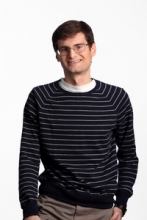
IRG2 strives to understand the processes of electron transfer at electronic interfaces and to exploit these processes in applications ranging from optoelectronics to photochemistry. The group’s work focuses on charge transfer in the technologically relevant donor/oxide semiconductor and organic semiconductor/nanocarbon systems. IRG2 combines theoretical and experimental approaches to quantify exciton energy transfer within the CNT film and to develop the means to accelerate it. IRG2 has also formed organic semiconductor transistors in which graphene electrodes form the contacts to the organic semiconductor layer. IRG2 is also investigating the dynamics and mechanism of N2 reduction by free electrons ejected from a diamond illuminated with deep ultraviolet light.
The Schmidt group applies a diverse set of computational approaches to study complex materials, often with direct applications to problems of relevance to energy / fuels. Our research spans the areas of statistical mechanics, electronic structure theory, and dynamics. We utilize both established and novel computational methodologies, including: atomistic molecular dynamics simulations, high-level electronic structure, energy decomposition analysis, QM/MM approaches, path-integral techniques, etc. Current areas of application include nano-porous materials for flue gas separation, enabling energy-efficient CO2 sequestration; and heterogeneous catalytic conversion of biomass to liquid fuel.
 One are of research focus is on CO2 adsorption and gas separation on porous metal-organic hybrid compounds known as zeolitic imidazolate frameworks (ZIFs), which have shown great promising in absorbing CO2, and also for separating CO2 from other gases such as N2 that are frequently found in the exhaust streams of coal power plants. We using high-level ab initio symmetry adapted perturbation theory calculations to develop physically-motivated force fields to enable a predictive understanding of the relationship between ZIF functionalization of the CO2 adsorption capacity and selectivity in these materials. We are also developing advanced simulation methods to enable order-of-magnitude increase in simulation throughput, thus facilitating high-throughput materials screenings.
One are of research focus is on CO2 adsorption and gas separation on porous metal-organic hybrid compounds known as zeolitic imidazolate frameworks (ZIFs), which have shown great promising in absorbing CO2, and also for separating CO2 from other gases such as N2 that are frequently found in the exhaust streams of coal power plants. We using high-level ab initio symmetry adapted perturbation theory calculations to develop physically-motivated force fields to enable a predictive understanding of the relationship between ZIF functionalization of the CO2 adsorption capacity and selectivity in these materials. We are also developing advanced simulation methods to enable order-of-magnitude increase in simulation throughput, thus facilitating high-throughput materials screenings.
 We are also working to develop new theoretical tools to facilitate a predictive understanding of heterogeneous catalyst systems. We recently developed an extension of the existing Natural Bond Orbital (NBO) orbital localization procedure (which has been tremendously successful in elucidating chemical reactivity in small-molecule systems) to solid-state periodic systems and surface models. The resulting NBO analysis yields a chemically-intuitive “general chemistry” Lewis-like picture of bonding between catalysts / adsorbate in terms of localized orbitals. We are exploring applications to catalytic screening, including new NBO-based catalyst “descriptors”.
We are also working to develop new theoretical tools to facilitate a predictive understanding of heterogeneous catalyst systems. We recently developed an extension of the existing Natural Bond Orbital (NBO) orbital localization procedure (which has been tremendously successful in elucidating chemical reactivity in small-molecule systems) to solid-state periodic systems and surface models. The resulting NBO analysis yields a chemically-intuitive “general chemistry” Lewis-like picture of bonding between catalysts / adsorbate in terms of localized orbitals. We are exploring applications to catalytic screening, including new NBO-based catalyst “descriptors”.
 We are also developing novel QM/MM-like approaches to facilitate computational studies of solution-phase heterogeneous catalysis. Such systems are becoming increasing relevant, particularly in the transformation of biomass to usable liquid fuel. Here many open questions remain regarding the role of solvent in modulating the activity / selectivity of the catalysts. Unfortunately, no existing computational approaches are able to address these systems due to the complex metal/adsorbate/solvent interface and the need to sample over many solvent configurations. Here we are developing several mixed QM/MM approaches to allow us to address this new class of systems.
We are also developing novel QM/MM-like approaches to facilitate computational studies of solution-phase heterogeneous catalysis. Such systems are becoming increasing relevant, particularly in the transformation of biomass to usable liquid fuel. Here many open questions remain regarding the role of solvent in modulating the activity / selectivity of the catalysts. Unfortunately, no existing computational approaches are able to address these systems due to the complex metal/adsorbate/solvent interface and the need to sample over many solvent configurations. Here we are developing several mixed QM/MM approaches to allow us to address this new class of systems.
Research in the group will offer opportunities for students in a variety of areas, including the use of existing simulation and computational programs and the design of novel computational algorithms. Students will not only learn to utilize existing codes to understand interesting phenomena, but also learn to extend existing methodology by implementing the algorithms that we will design.
Other research interests include the continued development and educational applications of the WebMO software package. WebMO provides an easy-to-use, web-based interface to many computational chemistry packages for both research and teaching applications. In the future I hope to integrate WebMO into several of the lecture and laboratory classes within the department.